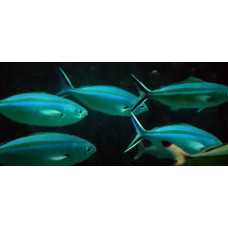Latin name
Caesio caerulaurea
Other names
Blue fusilier, gold-band fusilier or scissor-tailed fusili.
Identification
Body moderately large, spindle-shaped, somewhat compressed at the sides. Eyes large, eye diameter usually 3.4-4.2 times smaller than the length of the head. Mouth small, terminal, retractable. Small conical teeth on both jaws, scopa and palate. There are 57-65 scales on the lateral line.
Features of fish fins
The dorsal fin has 10 barb rays and 15 (rarely 14 or 16) soft rays. The anal fin has 3 barb rays and 12 (rarely 13) soft rays. The dorsal and anal fins are covered with scales. The pectoral fins have 20-22 (rarely 19) soft rays. The caudal fin is bifurcated.
Fish colouring
Upper body bluish, lower body white to pale bluish. There is a yellow band just above the lateral line, which runs one scale row above the lateral line on the caudal peduncle. The band is 2 or 3 scale rows wide; it is bordered immediately above and below by a white or light blue band one scale row wide (juveniles sometimes have another black band between the yellow band and each of the whitish outer bands). Caudal fin lobes with a black median stripe; the outer margin of each caudal lobe is often edged with white and the inner margins are pale. Pectoral, pelvic and anal fins white. The axilla of the pectoral fin is black with a black triangular spot above the base. The dorsal fin is light blue or pale with a black distal edge.
Distribution
Widespread in tropical and subtropical waters of the Indo-Pacific from the east coast of Africa and the Red Sea (absent from the Persian Gulf) to Samoa; north to southern Japan and south to Vanuatu and New Caledonia.
Habitat
A marine tropical species. Found at depths of 2 to 40 metres (6 feet 7 inches and 131 feet 3 inches), on coastal reefs, in lagoons and offshore, usually where there is healthy coral growth.
Size
Maximum body length 35 cm, usually up to 25 cm. Maximum recorded weight: 1.6 kg.
Behavior
Adults are found in schools in deep lagoons and along coastal reefs, mixing with other tuna species. They do not migrate.
Food and feeding habits
They feed on zooplankton.
Reproduction
They reach sexual maturity quite early, are highly fertile and lay many small pelagic eggs. Spawning occurs throughout most of the year and is manifested as mass spawning on lunar cycles.
Caesio caerulaurea has a distinct courtship pattern consisting. First, at dusk, 1-2 males approach the female and begin to pinch her abdomen, causing it to swell. This occurs 60-90 minutes before spawning. The fish then stop this behaviour and return to their schools. Less than 60 minutes before spawning begins, 2-6 males will compete to get their abdomen as close to the female's abdomen as possible. Once the male has driven the other males away, the pair spiral to the surface where they lay eggs and milk. They are followed by other 'sneaker' males who release their milk at the site where the original pair spawned. Sometimes a pair can escape the pursuit of the sneaker males.
Fishing
It is an important catch in coastal fisheries and is commonly found in fish markets in Indonesia and the Philippines. It is caught using set nets, gill nets, traps, trawls and lines. It is also fished illegally using explosives.
Relationship with a person
It is a delicacy fish with tender flesh and a flavour reminiscent of albacore. Caesio caerulaurea meat has no characteristic odour and is rich in essential omega-3 fats.
| Classification | |
| Phylum | Chordata |
| Class | Actinopterygii |
| Squad | Perciformes |
| Family | Caesionidae |
| Genus | Caesio |
| Species | C. caerulaurea |
| Features | |
| Conservation status | Least Concern |
| Habitat | Pelagic |
| Life span, years | No information |
| Maximum body weight, kg | 1,6 |
| Maximum length, cm | 35 |
| Sailing speed, m/s | No information |
| Threat to people | Edible |
| Way of eating | Planktonophage |
Blue and gold fusilier
Tags: blue and gold fusilier



